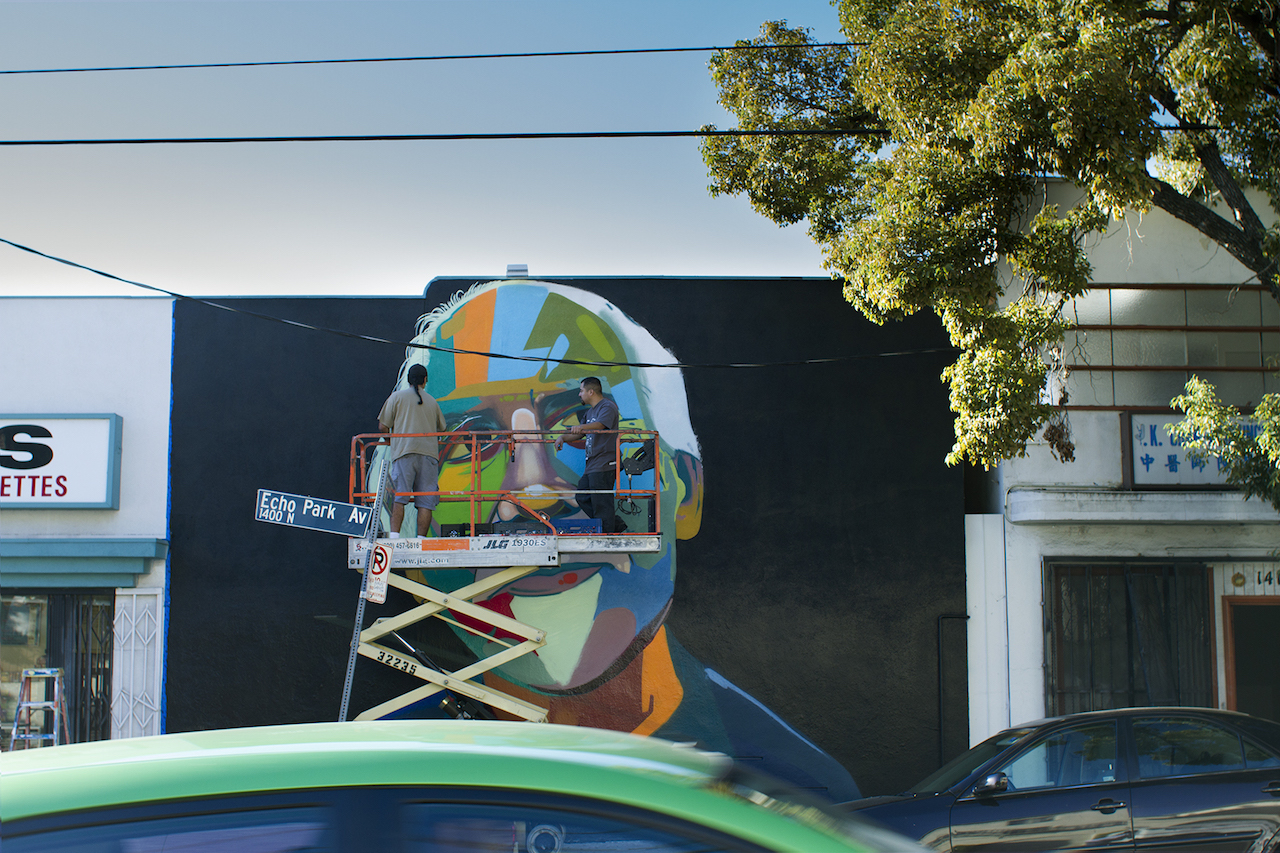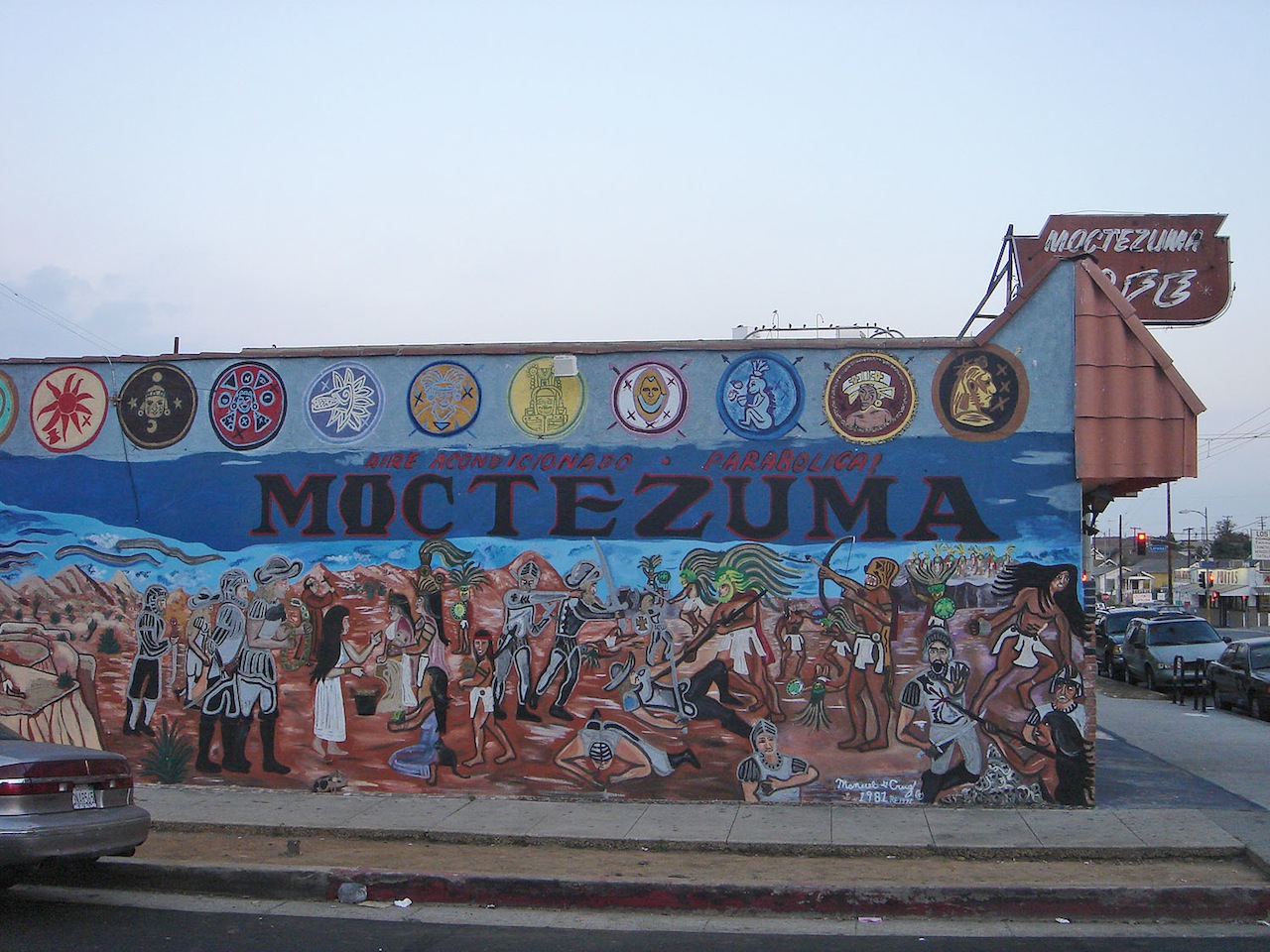01 Feb An LA Muralist on Preserving the Local History of Street Art

Man One’s second #FacesLA mural, in progress (all photos by Mars Sandoval unless otherwise noted)
Originally published by Hyperallergic.com
By John W. Zeiser
January 27, 2016
LOS ANGELES — Just east of the LA River runs Mission Road, an industrial street crammed with auto body shops and salvage operations. I’m biking, and when the potholes thin out, I have a chance to look up. The view is dominated by the Piggyback Yard, a Union Pacific property, and one of the more contentious development sites abutting the river. Most recently, the city abandoned plans to develop it as part of LA’s 2024 Olympics bid, and, for now, the yard remains a vast expanse of train tracks, shipping containers tagged with graffiti, and scraggly weeds.
I’m headed northeast to Lincoln Heights to meet the mural artist Alex Poli Jr., a.k.a. Man One, whose studio sits just across the street from El Parque de Mexico. He has been on the front lines of LA’s graffiti art for decades now. Born, raised, and educated in LA, he founded the Crewest Gallery in 2002, which aimed to provide artists a legitimate space to display their work during LA’s 10-year mural moratorium, in which all street art was bannedin the city. After the Crewest Gallery, which represented graffiti artists, closed in 2012, he moved into his new studio into LA’s oldest suburb, Lincoln Heights.

Man One’s studio in Lincoln Heights
The studio is as bright and clean as the outside is dingy, but still Man One apologizes for the mess. His long black hair is pulled back, revealing shorn sides growing out again; a goatee stands against a few days of stubble. His glasses look light enough to float away. He’s getting ready for a holiday party, and there is a lot of work strewn about. Canvases and panels are everywhere. In true LA fashion, a set of three buffed, shiny car hoods hang from the 20-foot walls with Man One’s signature use of bright colors and loopy, ghostly white figures that elongate like pieces of spaghetti.
The long, relatively narrow studio is roughly divided by enormous cubbies stuffed with monographs, portfolios, coffee cans full of paintbrushes, intricately painted calaveras, and all sorts of collectibles. The rhythmic sound of sewing machines muffles through the walls. Man One tells me he’s the first non-sweatshop to be in the building for 25 years, possibly a sign of the times, or maybe just one of those LA juxtapositions, something beautiful in an endless sea of concrete and freeways.
I’ve come specifically to talk about Man One’s new mural series #FacesLA. The previous week I met him finishing up his second wall for the series, a portrait of a local photographer, Eriberto Oriol, whom Man One has rendered almost like a stained glass window. It sits next to a donut shop along a stretch of Echo Park Ave. His first in the series is in downtown LA, on an alley off of 8th and Flower Street. In similar blocks of color as the Oriol piece in Echo Park, the mural depicts a young boy looking to the sky. In gray outlines the word “Volar,” Spanish for “to fly,” radiates across the blackness of the wall.

Finished mural with artist and subject, Eriberto Oriol
This new project is thanks to the large coalition of artists and activists, including Man One, who helped end the mural moratorium. Lifted in 2013, there’s now a new permitting process for street art overseen by the Department of Cultural Affairs as well as one for establishing the preservation of a mural. Man One wanted to take advantage of his newfound status as a “legal” graffiti artist, deciding “to focus on LA and just on people who live in LA, who are born and raised in LA, who are local activists, artists, kids, grandmothers.”
#FacesLA is being overseen by the Mural Conservancy, and four murals have already been funded by collectors. The next is set to depict a family friend who used to own a flower shop. She was a neighborhood fixture for years, but after her son was diagnosed with ALS she closed up shop to go to nursing school in order to be his nurse. “I would love to portray and honor her in that way,” he says. The other, to go in at the Southern California Library for Social Studies and Research in South Los Angeles, is intended as a companion to his “They Claim I’m a Criminal,” a mural at the library he painted in 2010 honoring the Coalition Against Police Abuse and Mothers ROC.
Man One hopes this is just the beginning of a larger project. He’s already in talks to execute one mural along the LA River with the help of the Friends of the LA River, a nonprofit whose mission is protecting and restoring the natural and historic heritage of the site.
The river is a proverbial elephant in the city’s room, and a struggle is brewing over plans for it and adjacent properties like the Piggyback. People are already talking about it becoming LA’s riparian response to New York’s Highline, a rehabilitated locale with its own development issues. “The fear is that it’s just going to be people who have no history with the river, no history with those communities around the river, [who] are just going to come exploit the whole area,” Man One explains, pointing out that Frank Gehry’s involvement has put “people on alert, because now there’s money and big people are showing up to the table.” As if this wasn’t enough, this summer saw the city win a $1 million public grant from Michael Bloomberg’s charity for a water-themed river biennial.

Highland Park Library mural (photo by Cherlyn Johnson/Flickr)
For Man One, the river has been a proving ground for graffiti and mural artists for decades. He began tagging there in ’87. “As artists, that’s one of the largest canvases we’ve got in the city,” he says, stressing that “whatever happens to the river and any of these projects in the future, there has to be an element of the actual art created in the river be by Angelenos.”
Similar to worries over local input into development, community control over LA’s mural art is a growing concern for local artists like Man One. Its Southern California forms are rooted in a history that spans from Diego Rivera to the Chicano Art Movement. “I’ve always seen what we’re doing, as graffiti artists, especially from this side of town, as part of that lineage … that’s strictly LA.” One of the central features of these movements, and one essential to Man One’s current project, is the choice of subject. Rather than focus on the famous or recognizable, Chicano muralists, for example, depicted grape pickers, city laborers, people with connections to neighborhoods. Murals in LA often provide visual history lessons. They ground the viewer in the nitty-gritty of a specific location rather than call out with something instantly recognizable.

Mural in East LA recalls Mexican history and forms (photo by IK’s World Trip/Flickr)
However, this local tradition based on history and community is at odds with many of the new murals that seem to appear overnight. “In the Arts District you see a lot of the murals that are not based in our Chicano roots, that are more just aesthetically nice-looking pieces of work, with a very different mindset.” He assures me that he’s got nothing against such pieces, there’s plenty of space for all kinds of mural art in a city the size of LA. Nevertheless, there lies a tension between local artists and those flying in to throw up a massive piece in a weekend, then leaving. “I always want to think of my work as existing beyond a week or two weeks or a month,” he says, recalling his childhood when he enjoyed murals by the East Los Streetscapers or George Yepes. A feeling of recognition was essential for the young Man One. The graffiti community’s local, site- or community-specific themes evolved and took on additional meaning as he got older, he says. “You don’t take it all in one day”; instead, “it lives with you all those years.”
On my way home, I start to appreciate something Man One said when we touched on the influx of artists and galleries, especially those from New York City. He said that outsiders typically “don’t understand how LA is organized.” They think beaches, sun, and celebrity, that the east side is anything east of Fairfax; the exact things that LA is not for most of the 13 million people who call the county home. Man One is avoiding those themes in his murals because, “what I’m trying to do with the FacesLA program is just show hey, there are all kinds of interesting people here. And they all make part of this fabric that we call LA.”
The rubble and weeds stretching towards the river have a slightly different meaning now. They remind me that when you expect a city to be a certain way, often, you end up neglecting local geography, communities, and the way they already use space.

A tagger under the Hyperion Bridge, Los Angeles River (photo by Clinton Steeds/Flickr)
Crossing Cesar Chavez heading west, I stop to look at the river more closely. It isn’t much more than a massive storm drain — its long, concrete walls a blank canvas everyone has designs on. The eastern side is tagged with names, a few crude figures made by budding artists in their open-air studio. When I get to the western side, the walls have all been painted over.

